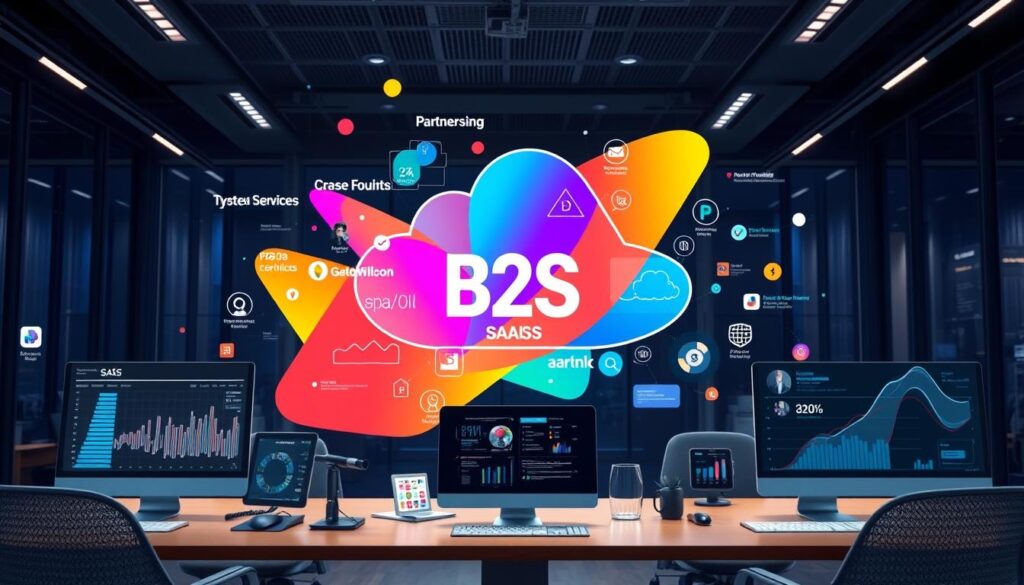In the competitive world of B2B SaaS, are you using the right partnerships to grow your business? With 69% of sales reps falling short, traditional growth strategies might not cut it. Let’s look at how strategic partnerships can change your software and business tactics.
The B2B SaaS world is changing fast, and companies are seeing the value of partnerships. In fact, half of B2B companies are putting more money into partnerships this year. These partnerships are not just for networking; they can change your business model and speed up growth.
There are many types of B2B SaaS partnerships, each with its own benefits. For example, referral partners give you better leads because of trust. Reseller programs open up new ways to sell your product. Strategic alliances and tech partnerships can make your product better and keep customers coming back.
As we explore the five key partnerships for B2B SaaS success, ask yourself: Are you ready to use collaboration strategies that could change your market position and drive huge growth?
Key Takeaways
- Half of B2B companies are increasing partnership investments
- Referral partnerships lead to higher conversion rates
- Reseller programs provide access to established distribution channels
- Technology partnerships enhance product capabilities and customer retention
- Co-marketing efforts can significantly boost ROI and content reach
Understanding B2B SaaS Partnerships

B2B SaaS partnerships are changing the tech world. They bring together software providers and offer chances for growth and new ideas. Let’s explore what B2B SaaS is and why partnerships are key in this field.
What is B2B SaaS?
B2B SaaS means cloud-based software sold to businesses. It helps companies work better, be more productive, and change digitally. It covers many needs, like managing customers or tracking projects.
Importance of Partnerships in B2B SaaS
Partnerships are essential for B2B SaaS growth. They open up new markets, improve products, and speed up sales. Strategic partnerships can bring in more money than paid sales, making them crucial for fast-growing companies.
Here are some interesting facts:
- 66% of B2B leaders using channel sales expect revenue growth of over 11% in 2023
- 58% of sales in top SaaS companies come through partners
- By 2030, ecosystems could drive $80 trillion in annual revenue
These figures show the strength of technology partnerships and co-selling. Channel partner programs let SaaS companies use other companies’ customers and knowledge. This way, they can grow fast without needing more sales teams.
“86% of enterprise buyers reported selecting products they’d heard of before even starting the research process.”
This fact shows how important partnerships are for visibility. By working with well-known companies, B2B SaaS can get more noticed and trusted. This leads to more leads and sales chances.
Types of B2B SaaS Partnerships

B2B SaaS partnerships come in many forms. Each offers unique benefits for growth and expansion. These collaborations help companies enter new markets, improve their offerings, and boost revenue.
Reseller Agreements
SaaS reseller partnerships let third parties sell a company’s software. This model grows market reach without big investments. For example, NetSuite’s referral partners get a 10% commission on new customers’ first-year payments.
This arrangement helps both sides, increasing sales and expanding the customer base.
Technology Partnerships
Technology partnerships involve combining software solutions. Groove, for instance, works with over 4,000 apps, helping everyone grow. These partnerships aim to improve product functionality and user experience, not just for money.
They create a team effort that benefits all involved.
Affiliate Partnerships
Affiliate partnerships use trackable links for promotion, with commissions based on sales. Lead generation partners for SaaS can earn a lot. Many companies offer tiered structures, increasing commissions as sales grow.
ActiveCampaign gives out promotional tools like graphics and webinars to help affiliates succeed.
SaaS indirect sales partners are key in expanding market reach. They offer installation, customization, and ongoing support. This adds value to SaaS offerings through specialized services.
This model lets SaaS companies use partners’ industry knowledge and customer connections.
“Partner programs have been instrumental in accelerating growth, retaining users, and increasing revenue for leading SaaS brands like HubSpot and SEMrush.”
These partnership types offer many chances for B2B SaaS companies to grow. They can improve their products, reach new markets, and boost revenue.
Benefits of B2B SaaS Partnerships

B2B SaaS partnerships offer many benefits to tech companies. They help with growth, efficiency, and innovation. Let’s look at the main advantages of these partnerships.
Expanding Market Reach
Partnerships in SaaS open up new markets and customers. Companies use partners’ networks to grow fast. About 40% of SaaS businesses enter new markets through alliances.
Cost Efficiency
One big plus of B2B SaaS partnerships is saving money. Companies with partner marketing see a 28% revenue increase. They also cut customer costs by up to 50% through co-marketing.
This helps businesses use their resources better and improve profits.
Enhanced Service Offerings
Partnerships let SaaS companies offer more without big development costs. They integrate other solutions to meet new needs. This makes customers happier and keeps them coming back.
In fact, partnerships can increase customer retention by up to 30%. This benefits both partners and clients.
The perks of B2B SaaS partnerships go beyond these points. They drive innovation and help the industry grow. As the SaaS market grows, alliances will be key in shaping tech’s future.
How to Choose the Right Partnership
Finding the perfect partnership is key for SaaS companies. The right one can expand your market and grow your business. It’s all about careful checking and planning.
Assessing Compatibility
When looking at potential partners, think about their products, users, and market spot. Look for strengths that match your goals. A good match can lead to strong B2B partnerships.
Evaluating Partners’ Strengths
Check out your potential partners’ market share, tech skills, and customer happiness. Use tools like SEMRush to see their rankings for important terms. This helps find partners who can boost your SaaS.
Setting Clear Goals
Make clear, measurable goals for your partnership. For example, aim to get a certain number of leads or boost web traffic. Clear goals guide you and show if you’re succeeding.
“Greater marketing exposure through partnerships can dramatically decrease the speed to market while increasing the quantity and quality of feedback from the target market.”
Good partnerships share leads and help with conversions. Leads from partners often close faster than others. By picking the right partner and setting clear goals, you can grow and innovate in the B2B SaaS world.
Navigating Partnership Agreements
Creating strong partnership agreements is key for SaaS program success. These agreements are the foundation of B2B SaaS contract talks. They make sure everyone is on the same page and safe.
Key Elements to Include
A good agreement should cover how money is made and shared. It’s common for SaaS partnerships to share revenue, with partners getting 20% to 50%. Referral fees can be 5% to 30% for new clients.
Include sales tips, meeting plans, and how to handle objections. Set SMART goals for your partnership, like working with 20 local resellers in a year. This gives a clear path to market entry.
Legal Considerations
Make sure your agreement covers important legal points. About 70% of SaaS companies use SLAs to set performance standards. DPAs are included for data protection, and 80% of contracts have indemnification clauses to protect against risks.
Managing Expectations
Good communication is vital for managing expectations. Set up regular updates and feedback channels. Create a Partner SOP that outlines goals, messaging, and strategy.
This can lower conflict chances, as clear terms reduce disputes by 50%. Focus on these elements for strong agreements that grow revenue and succeed in the long run. Start building your high-impact SaaS partner program for new growth.
Successful Partnership Case Studies
B2B SaaS success stories show the strength of strategic partnerships. These examples prove how companies can grow a lot through smart alliances.
Notable Examples
Digital Edge teamed up with Palm Springs Convention Center. Their work together created an award-winning microsite. This site greatly increased venue leads. It shows how marketing partnerships can be very powerful in B2B SaaS.
SmartBuyGlasses and Time Doctor also made a big impact. Their partnership led to a huge increase in performance. It also cut down on compliance issues by 50-75%. These results show how good partnerships can change things for the better.
Lessons Learned
These case studies teach us important lessons:
- Strategic alignment is key for success
- Regular communication makes partnerships better
- Working together on sales can greatly improve results
- Helping partners learn about your product is essential
Success in partnerships often comes from understanding each other well. By focusing on this, B2B SaaS companies can create alliances that help them grow and innovate.
Common Challenges in B2B SaaS Partnerships
B2B SaaS partnerships often face hurdles that can hinder success. Understanding these challenges is crucial for effective partnership conflict resolution and overcoming SaaS collaboration hurdles.
Communication Issues
Clear communication is vital in B2B SaaS partnerships. A study reveals that 60% of partnerships fail due to poor communication and misaligned goals. Regular check-ins and transparent dialogue can help address this issue.
Misaligned Objectives
When partners have different goals, it can lead to friction. 90% of successful partnerships are characterized by aligned objectives. Setting clear, mutual goals from the outset is key to avoiding this pitfall.
Resource Allocation
Proper resource management is crucial in B2B SaaS partnerships. About 40% of companies struggle with integrating systems, which can strain resources. Effective allocation and planning can help overcome this challenge.
“Partnership conflict resolution requires open communication, aligned goals, and smart resource management.”
By addressing these common challenges, B2B SaaS partnerships can thrive. Remember, 63% of providers report a direct link between effective partnerships and higher customer retention rates. Overcoming these hurdles is not just beneficial—it’s essential for long-term success in the competitive SaaS landscape.
Building and Maintaining Partnership Relationships
Strong B2B relationship management is key for SaaS partner success. It’s all about open communication and regular reviews. These steps keep partnerships working well for everyone.
Open Communication Strategies
Good communication is the heart of any partnership. In SaaS B2B, it means staying in touch and sharing openly. Many companies hold monthly sessions for their partners.
These sessions cover important topics like partnership updates, product news, and how solutions work together.
For example, Workday and ADP worked together to make data sharing better. This helped their customers get the most out of their technology. It shows how open talk can lead to new ideas.
Regular Performance Reviews
Checking how partnerships are doing is essential for lasting success. Holding reviews every two weeks or monthly helps partners stay on track. These reviews should cover:
- Looking at important performance signs (KPIs)
- Talking about problems and chances
- Sharing stories of success and feedback
A Gartner 2023 study found that buyers value tech integration highly. This highlights the need for regular checks to ensure everything works smoothly. It keeps customers happy and partnerships strong.
“Integration partnerships need careful planning. This includes setting up how to measure success and share product updates.”
By focusing on clear communication and regular checks, B2B SaaS partnerships can grow. They reach more markets, improve products, and make customers happier.
Future Trends in B2B SaaS Partnerships
The B2B SaaS world is changing fast. New partnership models are making a big impact. With the global SaaS market set to grow by 13.7% by 2031, partnerships will be key to innovation and growth.
Evolving Market Dynamics
The SaaS industry is expected to hit $829.3 billion by 2031, up from $296.9 billion in 2023. This growth is leading to new partnership strategies. By 2025, 85% of business apps will be SaaS-based, opening up chances for collaborative solutions.
The Role of Technology in Partnerships
AI is set to change B2B partnerships. AI’s market value is expected to reach $1,812 billion by 2030. We’ll see more machine learning for matching and tracking partners’ performance. Low-code and no-code platforms, set to triple by 2025, will make integrations between partners faster.
As the B2B SaaS world keeps evolving, partnerships will aim for comprehensive ecosystem solutions. By 2025, 80% of B2B SaaS sales will happen online. This will make digital-first collaboration models the standard, changing how companies form and keep strategic alliances in the SaaS world.

